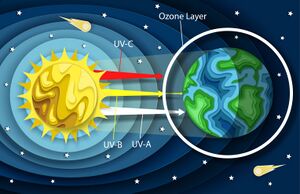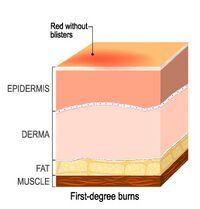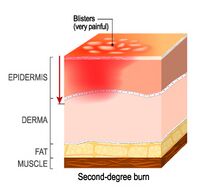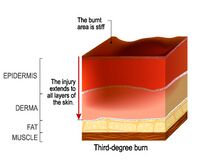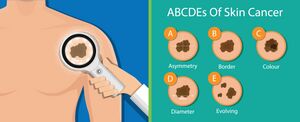The Built Environment and Ultraviolet Light as Environmental Concerns in Sport
Original Editor - Wanda van Niekerk based on the course by James Laskin
Top Contributors - Wanda van Niekerk and Jess Bell
The Built Environment as an Environmental Concern[edit | edit source]
The following factors are important environmental concerns in the built environment in sport:
- Practice/competition facilities
- Playing surface
- Artificial turf versus natural grass playing surfaces
- Artificial turf as an alternative to natural grass has several advantages in terms of[1]:
- cost
- durability
- maintenance of the turf
- multipurpose use
- There are however also concerns about athlete safety with the possibility of higher injury rates on artificial turf compared to natural grass. Gould et al.[1] conducted a systematic review on the risk of lower extremity injuries across all sports and reported the following[1]:
- a higher rate of foot and ankle injuries on artificial turf compared to natural grass (this was seen on old- and new generation turf)
- hip injury and knee injury rates are similar between the two playing surfaces (artificial vs natural grass)
- in elite-level football athletes this may not be the case, though, with reports that these athletes are more predisposed to knee injuries when playing on an artificial turf compared with playing on natural grass
- there are a few articles that report a higher injury rate on natural grass, but there seems to be concern about bias in these studies as many of these studies received funding from the artificial turf industry.
- O'Leary et al. found that concussion rates in competitive contact sports were lower on artificial turf compared to natural grass. Sports such as American football and rugby had decreased risk of concussion and head injury on artificial turf, but soccer indicated no statistical difference in concussion rates on artificial turf compared to natural grass.[2]
- Field maintenance of artificial turf and natural grass is important to protect athletes from injury[3]
- Artificial turf has lower maintenance costs thus it is a good option for sports organisations where a wide variety of sports need to share a single field.[3]
- Read more on Athletic play surfaces and injury risk[4]
- Artificial turf as an alternative to natural grass has several advantages in terms of[1]:
- Artificial turf versus natural grass playing surfaces
- Lighting
- The task of lighting a sports field is a complex and important feature. Adequate and suitable lighting helps both athletes and spectators in terms of general safety. Poor lighting may increase the risk of injury and may even influence the course of the match played.[5] Proper illumination of a sports playing field can improve player performance, reduce injury risk and the competition may be more balanced.[6] Bright stadium lights may be distracting, but with the use of light emitting diodes (LED) lighting this can be addressed. LED lighting used in sports is different to the type of lighting used in offices and homes. The brightness of these lights are closer to the brightness of the sun and they improve visibility and clarity. LED lighting also allows for uniform lighting on a sports field which can, for instance, make tracking a ball easier.
- Interesting blog post to read: How does LED light improve sports players performance[7]
- Spectator proximity / behaviour
- Spectator proximity to athletes may be a danger to athletes and to other spectators. Examples of this are often seen in races such as the Tour de France cycle tour where spectators are roadside and the behaviour of these spectators can cause cyclists to crash and be seriously injured. Other examples are when spectators are unhappy with their team and throw objects at players or even attempt to get on the field of play to confront athletes.
- Spectator behaviour can influence athlete performance in various ways.[8]
- Spectators can be supportive or non-supportive, and this can have a psychological effect on athletes.[8]
- The presence of spectators has been shown to "enhance the dominant responses of the performer". McCarrick et al.[9] analysed home advantage in European football leagues of the 2019/2020 season. The first part of the season was played with spectators present and the latter without any spectators. The study showed that in games without spectators there were less offensive opportunities for players, resulting in fewer goals scored and fewer points gained in the league.[9]
- Most children enjoy having their parents as spectators, but sometimes their presence can lead to anxiety, especially when parents are exhibiting negative behaviour and derogatory comments.[8]
- Violent behaviour by spectators can be caused by factors such as[8]:
- psychological factors (feeling of adrenaline)
- influence of alcohol
- sporting rivalries
- socio-political factors
- reaction to their team's performance
- Racism in sport has recently been in the spotlight with spectators insulting players, petitions against contracting certain athletes, and the setting-up of racist banners.[8]
- Athletes do feel the pressure from spectators and it may influence the skills of individual players and the performance of the team.[8]
- Transportation
- Local transportation - how does the athlete get to and from practice or competition facilities?
- Travel - competitions away from home, transportation arrangement from hotel to sport facilities, travel fatigue and jet lag[10]
- Accommodation
- Food
Ultraviolet Light and Athletes[edit | edit source]
The performance of physical exercise and sports activities outdoors are associated with the development of skin cancer.[11] There is a direct relationship between ultraviolet radiation (UVR) and melanoma and basal cell carcinoma. Sun exposure has been shown to be a risk for skin cancer in outdoor sports.[11] The short-term risk of ultraviolet light exposure is sun-burn, and long-term risks are cancer (melanoma, basal cell cancer and squamous cell cancer).
The UV radiation spectrum is divided into three regions[12]:
- UVA
- responsible for about 90% of UV
- causes sunburn
- penetrates through deep cutaneous layers
- damages DNA via free radical formation
- contributes to skin ageing and wrinkling
- UVB
- biologically active but cannot penetrate beyond the superficial skin layers
- responsible for delayed tanning and sunburning
- enhances skin ageing
- promotes the development of skin cancer
- most of the UVB rays from the sun are filtered by the atmosphere
- UVC
- most damaging
- completely filtered by the atmosphere and does not reach the surface of the earth
Read more: Radiation: Ultraviolet (UV) radiation
UV Index[edit | edit source]
- A measure of the level of UV radiation
- Values of the index range from zero upward - the higher the UV index, the greater the risk of damage to the skin and eye, and the less time it takes for damage to occur
- Read more: Radiation: The ultraviolet (UV) index
| Exposure category and description | Index Number | Category colour | Sun Protection Messages | Sunburn Time |
|---|---|---|---|---|
| Low
No danger to the average person |
0 - 2 | Green | Wear a hat and / or sunglasses
Sunglasses on bright days Winter - reflection of snow can nearly double UV strength If you burn easily, cover up and use sunscreen |
1 hour + |
| Moderate
Little risk of harm from unprotected sun exposure |
3 - 5 | Yellow | Wear a hat and sunglasses
Use SPF 15+ sunscreen |
40 minutes |
| High
High risk of harm from unprotected sun exposure |
6 - 7 | Orange | Wear a hat and sunglasses
Use SPF 30+ sunscreen Cover body with clothing Avoid the sun if possible |
30 minutes |
| Very high
Very high risk of harm from unprotected sun exposure |
8 - 10 | Red | Wear a hat and sunglasses
Use SPF 30+ sunscreen Cover body with clothing Avoid sun if possible |
20 minutes |
| Extreme
Extreme risk of harm from unprotected sun exposure |
11+ | Purple | Take all precautions possible
Seek shade, cover-up, hat and sunglasses, use sunscreen Beachgoers should know that white sand and bright surfaces reflect UV and will increase UV exposure It is advised to stay indoors |
Less than 15 minutes |
Sunburn Stages[edit | edit source]
Sunburn = Flush damaged skin caused by overexposure to UV rays from the sun[13]
- Can be mild or severe
- First-degree sunburn
- only skin surface (epidermis) is affected[13]
- signs include:
- redness
- swelling
- pain
- superficial damage
- Second-degree sunburn
- affects the epidermis (outer-layer) and the dermis (underlaying layer of the skin)[13]
- signs include
- blistering
- pain
- swelling
- redness
- Third-degree sunburn
- affects the deep hypodermis, dermis and epidermis[13]
- signs include:
- skin carbonisation or translucent white colour of the skin
- coagulated and visible vessels under the skin surface
What to expect when you get a sunburn[edit | edit source]
Below are the stages of sunburn what to expect after getting sunburned:
- Stage 1
- first 1 to 3 hours
- increased blood flow to the area
- skin turns pink and feels warm to the touch
- skin may swell and feel painful
- Stage 2
- first 24 hours
- full effect of sunburn sets in
- peak in redness of skin
- skin is red, hot, painful and inflamed
- blistering may occur
- Stage 3
- 3 days to 2 weeks
- skin starts to return to normal
- decrease in redness
- flaking and peeling of skin as body sheds damaged cells
Skin types and the risk of sunburn[edit | edit source]
| Type | Natural skin colour | UV Sensitivity | Tendency to burn |
|---|---|---|---|
| 1 | very fair, pale white, often freckled | highly sensitive | always burns, never tans |
| 2 | fair, white skin | very sensitive | burns easily, tans minimally |
| 3 | light brown | sensitive | burns moderately, usually tans |
| 4 | moderate brown | less sensitive | burns minimally, tans easily |
| 5 | dark brown | minimal sensitivity | rarely burns |
| 6 | deeply pigmented dark brown to black | minimal sensitivity | never burns |
Other methods of skin typing include[14]:
- Lancer ethnicity scale
- Fanous skin classification
- Goldman world classification scale
- Taylor hyperpigmentation scale
- Roberts skin type classification system
Identification of early melanomas[edit | edit source]
Early melanomas may have clinical features that follow this ABCDE mnemonic[15]:
- A = Asymmetry
- B = Border
- C = Colour
- D = Diameter
- E = Evolving
Conclusion[edit | edit source]
The built environment in sports encompasses many factors that influence athletes and spectators, thus making it an important area for environmental concern. Choices between artificial turf and natural grass as playing surface has sparked debate. While artificial turf offers advantages in terms of cost, durability and multipurpose use, there are still concerns about athlete safety. Lightning of an stadium or event also plays a key role in ensuring safety and performance. Innovative technologies such as LED lightning has been a game changer in enhancing visibility and reducing injury risk. Spectator behaviour is often overlooked, but it can affect athletes psychologically. Supportive spectators boost performance, while negative behaviour can lead to anxiety and impact athletes' skills. Moreover, the impact of the built environment extends to transportation, accommodation and exposure to ultraviolet light. It is essential to understand these aspects as they collectively shape the sporting experience for all. This highlights the need for comprehensive environmental considerations in sports.
References[edit | edit source]
- ↑ 1.0 1.1 1.2 Gould HP, Lostetter SJ, Samuelson ER, Guyton GP. Lower extremity injury rates on artificial turf versus natural grass playing surfaces: a systematic review. The American Journal of Sports Medicine. 2023 May;51(6):1615-21.
- ↑ O'Leary F, Acampora N, Hand F, O'Donovan J. Association of artificial turf and concussion in competitive contact sports: a systematic review and meta-analysis. BMJ open sport & exercise medicine. 2020 May 1;6(1):e000695.
- ↑ 3.0 3.1 Gosnell G, A. Gerber B, P. Guyton G, P. Gould H. Playing Surface and Injury Risk: Artificial Turf Vs. Natural Grass [Internet]. Injuries and Sports Medicine. IntechOpen; 2023. Available from: http://dx.doi.org/10.5772/intechopen.106615
- ↑ Yurgil JL, Meredith TJ, Martin PM. Athletic play surfaces and injury risk. Current sports medicine reports. 2021 Apr 1;20(4):188-92.
- ↑ Tepina MS, Gorlenko NV, Murzin MA. Studying the Impact of the Light Environment on the Health of Athletes Using the Example of an Educational Institution. InIOP Conference Series: Earth and Environmental Science 2022 Feb 1 (Vol. 988, No. 2, p. 022069). IOP Publishing.
- ↑ Salis JP, Suresh A, Shailesh KR. Lighting Design of An Indoor Sports Facility-A Case Study. In2019 Second International Conference on Advanced Computational and Communication Paradigms (ICACCP) 2019 Feb 25 (pp. 1-5). IEEE.
- ↑ Sportlightsupply.com. How does LED light improve sports players performance. Available from https://sportlightsupply.com/how-does-led-light-improve-sports-players-performance/ (last accessed 01/02/2022)
- ↑ 8.0 8.1 8.2 8.3 8.4 8.5 Calleja P, Muscat A, Decelis A. The effects of audience behaviour on football players’ performance. Journal of New Studies in Sport Management. 2022 Mar 1;3(1):336-53.
- ↑ 9.0 9.1 McCarrick D, Bilalic M, Neave N, Wolfson S. Home advantage during the COVID-19 pandemic: Analyses of European football leagues. Psychology of sport and exercise. 2021 Sep 1;56:102013.
- ↑ Janse van Rensburg DC, Jansen van Rensburg A, Fowler PM, Bender AM, Stevens D, Sullivan KO, Fullagar HH, Alonso JM, Biggins M, Claassen-Smithers A, Collins R. Managing travel fatigue and jet lag in athletes: a review and consensus statement. Sports Medicine. 2021 Oct;51(10):2029-50.
- ↑ 11.0 11.1 De Castro-Maqueda G, Gutierrez-Manzanedo JV, Ponce-González JG, Fernandez-Santos JR, Linares-Barrios M, De Troya-Martín M. Sun protection habits and sunburn in elite aquatics athletes: surfers, windsurfers and olympic sailors. Journal of Cancer Education. 2020 Apr;35:312-20.
- ↑ World Health Organization. Radiation: Ultraviolet (UV) radiation. Available from: https://www.who.int/news-room/questions-and-answers/item/radiation-ultraviolet-(uv) (last accessed 29 March 2023).
- ↑ 13.0 13.1 13.2 13.3 Sánchez-Pérez JF, Vicente-Agullo D, Barberá M, Castro-Rodríguez E, Cánovas M. Relationship between ultraviolet index (UVI) and first-, second-and third-degree sunburn using the Probit methodology. Scientific reports. 2019 Jan 24;9(1):733.
- ↑ 14.0 14.1 Gupta V, Sharma VK. Skin typing: Fitzpatrick grading and others. Clinics in dermatology. 2019 Sep 1;37(5):430-6.
- ↑ Jicman PA, Smart H, Ayello EA, Sibbald RG. Early Malignant Melanoma Detection, Especially in Persons with Pigmented Skin. Advances in Skin & Wound Care. 2023 Feb 1;36(2):69-77.
